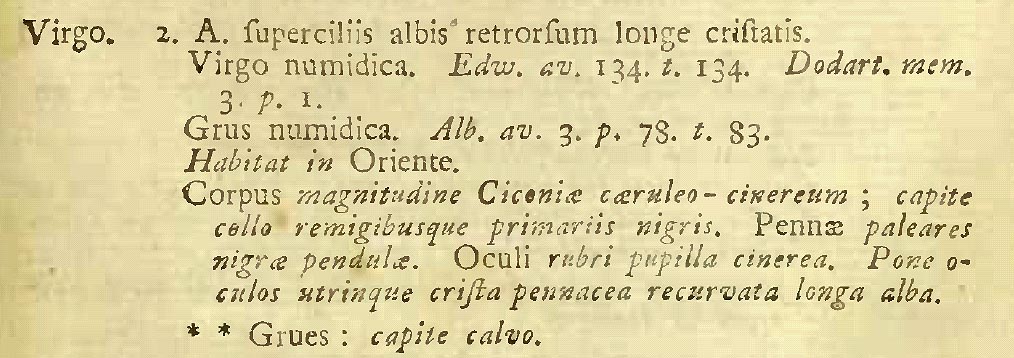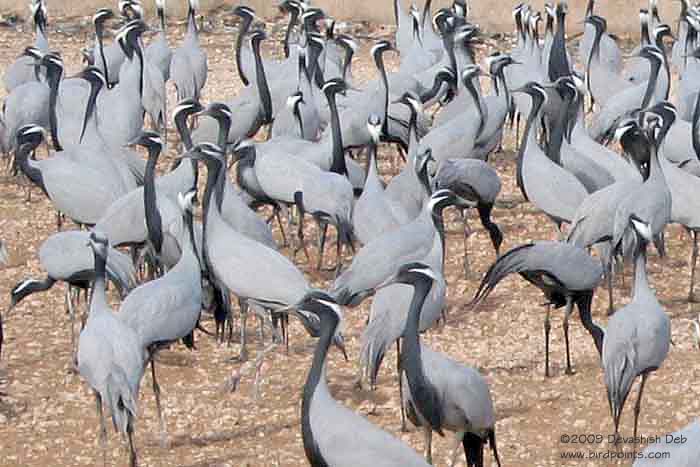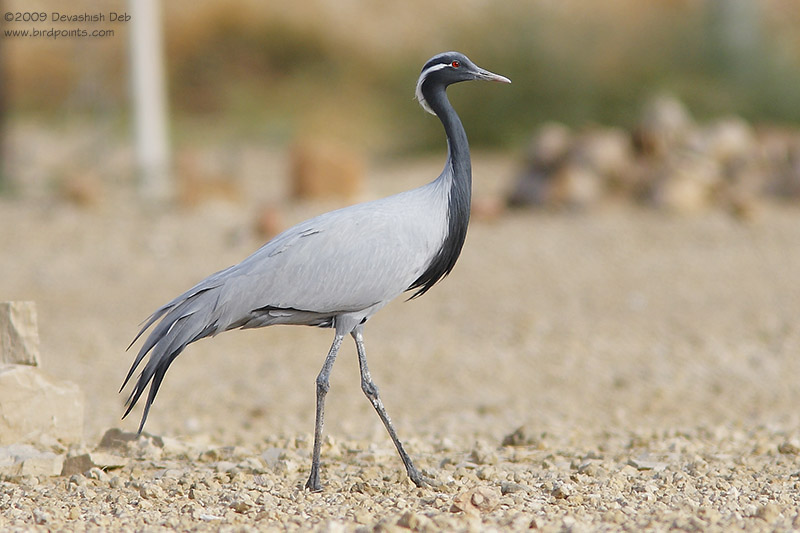|
|
| Demoiselle
Crane |
Grus
virgo |
6
June 2009 |
| Full
Species (monotypic); i.e. no subspecies/races Grus virgo; Linn. Syst. Nat. 10, p. 141 (1758) 
|
Pls use the mousewheel
to zoom in/out (Max 2X) |

|
Demoiselle Crane at Keechan, Rajasthan, India on 1 Mar 2009.
|
A large congregation of Demoiselle Cranes at Keechan, Rajasthan, India on 1 Mar 2009.
|
Historical
1411. Anthropoides virgo. The Demoiselle Crane. Ardea vlrgo, Linn. Syst. Nat. i, p. 234 (1766). Grus virgo, Pall. Zoogr. Rosso-Asiat. ii, p. 108; Scully, Ibis, 1881. p. 588. Anthropoides virgo, Viell. Nouv. Dict. D'Hist. Nat. ii, p. 163 (1816); Blyth, Cat. P. 274; Jerdon, B.I. iii, p. 666; Hume SF I, p235; Adam, ibid. p. 395; Butler, SF iv, p. 15; fairbank, ibid. p. 263; Hume, Cat. no. 866; Scully, S. F. viii, p. 352; Hume & Marsh. Game B. iii, p. 31, pi.: Biddulph, Ibis, 1881, p. 95; Butler, S. F. ix, p. 427; Reid, S. F. x, p. 68; Davidson, ibid. p. 320; Barnes, Birds Bom. p. 342; Sharpe, Cat. B. M. xxiii, p. 269. Coloration. Forehead, sides of crown, and sides of head, with the chin, throat, whole fore neck, and a broad ring round the nape black; feathers on lower eyelid, and a streak from the back of the eye over the ear-coverts, ending behind in a long plume, white; crown and the upper parts from a little behind the nape ashy grey; breast and abdomen the same, slightly darker; the sinciput streaked with black; winglet, larger primary-coverts, and primaries black, secondaries brownish grey tipped with blackish, and tertiaries, for the most part, with black tips; tail-feathers dark grey above, blackish below. Young birds have the head grey, streaked with black, and the lengthened plumes are ill-developed. Bill greenish, reddish at the tip; irides red; legs black. Length about 33; tail 6.5; wing 19; tarsus 7; bill from gape 3. Distribution. A migratory bird, breeding in Southern and Eastern Europe, Southern Siberia, and parts of Central and Western Asia, and spending the winter in North-eastern Africa, India, and China. In India it is most common in the Deccan, Guzerat, and Kattywar, occurring in immense flocks; less common, though far from rare, throughout North- western and Northern India, and in the Peninsula as far south as Mysore; it is rare farther south, though it has been seen at Kollegal, Coimbatore district, by Mr. Theobald, and it is said to occur even at Tinnevelly; but it is unknown on the Malabar coastlands, in Ceylon, in Lower Bengal, Assam, and Burma. Habits, &c. The Demoiselle arrives in India early in October, and leaves, as a rule, in April. Hume says the birds apparently arrive in Guzerat and the Deccan earlier than they do in Northern India and remain later, and he suggests that the birds so numerous in the Bombay Presidency may come from Africa. The habits of this bird resemble those of the Common Crane, but it associates in much larger flocks, and its call-note is quite different and much harsher. The flocks often spend hours during the day flying and circling in the air at considerable heights. The name of virgo is said to have been derived from the bird’s “ elegant appearance and dancing propensity” (H. T. Wharton). Blanford,
W.T. 1895-98. The Fauna of British India, Including Ceylon and Burma.
Birds.- Vol. III-IV.
866.-Anthropoides virgo, Lin. Native name-Karkarra. The Demoiselle Crane appears early in October-often I think in September-generally in vast flocks, either flying in a straight line or in a line which the letter M. represents very well. Occasionally, but rarely, they will settle on large shallow jhils; but on the Chowka and Gogra at Byramghat they are often numerous, particularly during the very cold weather. They migrate in March, going, as they came, in immense flocks. |
About/Terms of use etc. in the home page
Copyright © 2006-2009 birdpoints. All rights reserved.
